
The 8th Texas Cavalry Regiment (1861–1865), popularly known as Terry's Texas Rangers, was a light cavalry regiment of Texas volunteers for the Confederate States Army assembled by Colonel Benjamin Franklin Terry in August 1861. Though lesser known than the Texas Brigade, famous for their actions during the Battle of Gettysburg, the 8th Texas Cavalry distinguished itself at several battles during the American Civil War. In four years of service, Terry's Texas Rangers fought in about 275 engagements in seven states. The regiment earned a reputation that ranked it among the most effective mounted regiments in the Western Theater of the American Civil War.
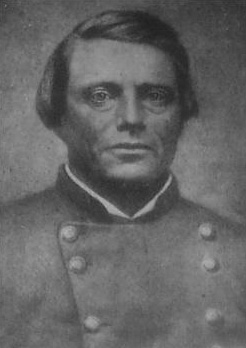
Thomas Green was an American soldier and lawyer, who took part in the Texan Revolution of 1835–36, serving under Sam Houston, who rewarded him with a land grant. Green was clerk of the Texas Supreme Court until the outbreak of the Civil War, when he became a Confederate cavalry leader. After winning several victories, including the Battle of Valverde and the recapture of Galveston, he was promoted brigadier and assigned command of the cavalry division of the Trans-Mississippi Department. In the Red River Campaign, he was mortally wounded while charging a fleet of Federal gunboats. The Union naval commander David Dixon Porter paid tribute to Green as a serious loss to the Confederacy.

The Fort McKavett State Historic Site is a former United States Army installation located in Menard County, Texas. The fort was first established in 1852 as part of a line of forts in Texas intended to protect migrants traveling to California. The fort was deemed unnecessary and abandoned in 1859 and was occupied by settlers. From 1861 to 1863, during the American Civil War, the fort became an outpost of Confederate forces on the Texas frontier until they left for other theaters of the war. When the US Army returned to Texas in the later 1860s, the fort was reoccupied and rebuilt, and became a base for the "Buffalo Soldier", or all-African American, 24th Infantry and 9th Cavalry Regiments.
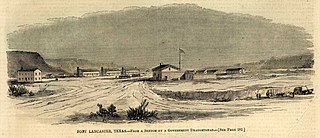
Fort Lancaster is a former United States Army installation located near Sheffield, Texas. The fort was established in 1855 on the San Antonio–El Paso Road to protect migrants moving toward California through Texas. The US Army occupied Fort Lancaster until Texas seceded from the United States in March 1861 and were replaced at the fort by forces loyal to the Confederate States of America. The Confederate Army held the fort from November 1861 until April 1862, when it was again abandoned and then burned.

The 12th Texas Cavalry Regiment was a unit of mounted volunteers recruited in Texas that fought in the Confederate States Army during the American Civil War. The regiment was enrolled in state service in September 1861 and in Confederate service the following month. The regiment fought at Whitney's Lane, Cotton Plant, and L'Anguille Ferry in 1862, Goodrich's Landing in 1863, and Blair's Landing and Yellow Bayou in 1864. The unit also participated in numerous skirmishes and scouts. It disbanded in May 1865.

The 27th Texas Cavalry Regiment, at times also known as Whitfield's Legion or 1st Texas Legion or 4th Texas Cavalry Battalion, was a unit of mounted volunteers that fought in the Confederate States Army during the American Civil War. First organized as the 4th Texas Cavalry Battalion or Whitfield's Legion, the unit served dismounted at Pea Ridge and First Corinth. Additional companies from Texas were added and the unit was upgraded to the 27th Texas Cavalry Regiment or 1st Texas Legion later in 1862. Still dismounted, the unit fought at Iuka and Second Corinth. The regiment was remounted and fought at Holly Springs in 1862, Thompson's Station in 1863, and at Yazoo City, Atlanta, Franklin, and Third Murfreesboro in 1864. The regiment surrendered to Federal forces in May 1865 and its remaining soldiers were paroled.
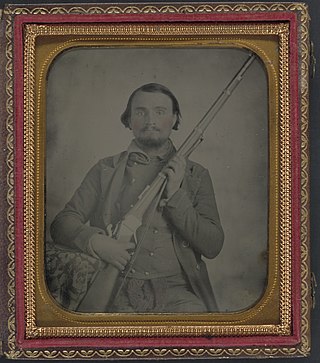
The 14th Texas Cavalry Regiment was a unit of mounted volunteers in the Confederate States Army that fought during the American Civil War. The regiment mustered as cavalry in the fall of 1861 but the soldiers were dismounted in March 1862 and served as infantry for the rest of the war. The regiment fought at the Siege of Corinth, and at Richmond, Ky., Stones River, and Chickamauga in 1862–1863. The unit fought in the Meridian and Atlanta campaigns and at Nashville in 1864, and at Spanish Fort and Fort Blakeley in 1865. The remaining 100 members of the regiment were paroled by Federal forces on 9 May 1865.

The 5th Texas Cavalry Regiment or 5th Texas Mounted Rifles was a unit of mounted volunteers from Texas that fought in the Confederate States Army during the American Civil War. The unit was organized at San Antonio in August 1861 for the purpose of invading New Mexico Territory. In 1862, the unit participated in the ultimately unsuccessful New Mexico Campaign. In 1863, the regiment fought at Galveston, Fort Bisland, Irish Bend, Second Donaldsonville, and Sterling's Plantation. In 1864, the unit was in action during the Red River Campaign. After being withdrawn to Texas, the regiment disbanded by June 1865.
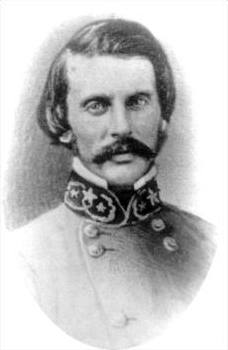
The 7th Texas Cavalry Regiment was a unit of mounted volunteers from Texas that fought in the Confederate States Army during the American Civil War. In the summer of 1861, the regiment was organized and mustered into Confederate service. In November 1861, it was assigned to a brigade that was tasked with capturing New Mexico Territory. In 1862, the regiment served in the unsuccessful New Mexico Campaign. In 1863, it was in action at Galveston, Second Donaldsonville, Kock's Plantation, and Bayou Bourbeux. In 1864, the regiment fought at Mansfield and Pleasant Hill in the Red River Campaign. The unit disbanded while in Texas in May 1865.

The 26th Texas Cavalry Regiment was a unit of mounted volunteers from Texas that fought in the Confederate States Army during the American Civil War. The unit first organized in August 1861 as the 7th Texas Cavalry Battalion with seven companies for the purpose of patrolling the Texas Gulf Coast. In January 1862, three companies were added, and the unit was renamed the 26th Texas Cavalry Regiment. The original colonel resigned and was replaced by Xavier Debray, a Frenchman educated at Saint-Cyr military academy. Constant drilling gave the unit its reputation as one of the best disciplined in Texas. Until 1864, the regiment only fought minor skirmishes with Union landing parties. That year it fought at Mansfield and Pleasant Hill in the Red River Campaign. Instead of disbanding in May 1865, the regiment stayed intact and briefly guarded the city of Houston against marauders.

The 23rd Texas Cavalry Regiment was a unit of mounted volunteers from Texas that fought in the Confederate States Army during the American Civil War. The unit first organized in spring 1862, but did not complete its 10-company organization until October 1862. Before being added to the regiment, one company was captured at Fort Donelson and was part of a prisoner exchange. The regiment became part of a brigade led by Hamilton Bee that was headquartered at Brownsville, Texas, and guarded the Texas Gulf Coast. In 1864, the brigade transferred to Louisiana and fought at Mansfield, Pleasant Hill, and Blair's Landing in the Red River Campaign. The regiment was dismounted to serve as infantry in February 1865 and surrendered to Federal forces in May 1865.

The 22nd Texas Cavalry Regiment was a unit of mounted volunteers from Texas that fought in the Confederate States Army during the American Civil War. The regiment first began organizing in late 1861 and by July 1862, it moved to the Indian Territory. The unit fought at Newtonia and McGuire's Store in fall 1862 and was dismounted soon after. The regiment fought as infantry at Prairie Grove in December 1862. It traveled to Louisiana in March 1863 where it joined a brigade led by Camille de Polignac. In 1864 the regiment fought at Mansfield, Pleasant Hill, and Yellow Bayou during the Red River Campaign. In March 1865 the regiment marched to Texas where it disbanded in May.

The 21st Texas Cavalry Regiment was a unit of mounted volunteers from Texas that fought in the Confederate States Army during the American Civil War. In spring 1862, George Washington Carter began organizing a lancer cavalry regiment in central Texas. So many men were recruited that two additional lancer regiments, the 24th and 25th Texas Cavalry, were formed. The three units moved to Arkansas where the 24th and 25th were dismounted to serve as infantry, but the 21st remained mounted. Since, the unit never received lances, it served as an ordinary cavalry regiment. The 21st Texas Cavalry fought at Cape Girardeau in 1863. It arrived too late to participate in the key battles of the Red River campaign in 1864, but fought at Yellow Bayou. In 1865, the unit moved to Texas where it disbanded at the end of the war.

The 19th Texas Cavalry Regiment was a unit of mounted volunteers from Texas that fought in the Confederate States Army during the American Civil War. The regiment mustered into Confederate service at the end of March 1862. It moved to Arkansas in fall 1862 and managed to avoid being dismounted as infantry, instead serving in William Parsons' cavalry brigade. The regiment fought at Cape Girardeau in 1863. The unit operated against Union supply lines and skirmished with Union forces in Arkansas and Louisiana. It arrived too late to take part in the main battles of the Red River campaign of 1864, but fought at Yellow Bayou. In 1865, the unit moved to Texas where it disbanded in May 1865.

The 2nd Texas Cavalry Regiment was a volunteer cavalry unit from Texas that fought in the Confederate Army during the American Civil War. The unit was organized in May 1861 as the 2nd Texas Mounted Rifles. In early 1862, the regiment took part in the unsuccessful New Mexico Campaign before retreating to Texas. In April 1862 the unit reorganized at Austin, Texas, as the 2nd Texas Cavalry. In January 1863, part of the regiment helped recapture Galveston while another part was captured at Arkansas Post. After moving to Louisiana, the unit fought at LaFourche Crossing, Second Donaldsonville, Kock's Plantation, Sterling's Plantation, and Bayou Bourbeux. It returned to Texas in winter 1863 and remained there until the surrender in June 1865.
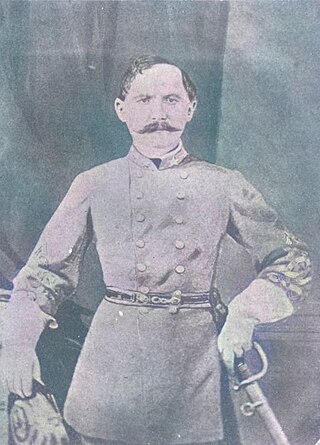
The 1st Texas Cavalry Regiment was a unit of mounted volunteers from Texas that fought in the Confederate States Army during the American Civil War. It was first organized as a 10-company regiment by Colonel Henry Eustace McCulloch in April 1861 and named the 1st Texas Mounted Rifles. In early May 1861, the regiment secured the surrender of the small Federal garrison of San Antonio. Except from a skirmish with Native Americans in November 1861, the regiment took part in no more actions. In April 1862, the unit was reduced to five companies and renamed the 8th Texas Cavalry Battalion. On 2 May 1862, William Overall Yager's 3rd Texas Cavalry Battalion was consolidated with the 8th Cavalry Battalion to form a new 1st Texas Cavalry Regiment under Colonel Augustus Buchel, a German soldier of fortune who emigrated to Texas in 1845. The regiment served on the Texas Gulf Coast in 1863 but later transferred to Louisiana. In 1864, it fought at Mansfield, Pleasant Hill, and Yellow Bayou in the Red River Campaign. After Buchel was killed at Pleasant Hill, Yager led the regiment for the rest of the war. The unit was included in the 2 June 1865 surrender.

The 31st Texas Cavalry Regiment was a unit of mounted volunteers from Texas that fought in the Confederate States Army during the American Civil War. Trevezant C. Hawpe organized the regiment in early 1862 with recruits mostly from Dallas County, Texas, and surroundings. In June 1862, it marched to Arkansas where it joined a brigade led by Douglas H. Cooper. The unit fought at Newtonia and McGuire's Store in autumn 1862 and subsequently dismounted to serve as infantry. The regiment served at Prairie Grove in December 1862. It moved to Louisiana in February 1863 at which time Hawpe resigned. The unit helped defeat a Federal force at Stirling's Plantation in September 1863. The following month it joined a brigade led by Camille de Polignac. In 1864 the regiment fought at Mansfield, Pleasant Hill, and Yellow Bayou during the Red River Campaign. In March 1865 the regiment marched to Texas where it disbanded in May.

The 33rd Texas Cavalry Regiment was a unit of mounted volunteers from Texas that fought in the Confederate States Army during the American Civil War. San Antonio merchant James Duff organized the 14th Texas Cavalry Battalion. In summer 1862, the Texas government ordered the battalion to suppress the Union Loyal League, which was composed of German Texans who opposed secession. When a group of Germans fled toward Mexico, Duff led a contingent of soldiers in a pursuit that ended in the so-called Battle of the Nueces in August 1862. Most of the Germans were killed in what some named a massacre. The 14th Battalion was subsequently expanded into the 33rd Texas Cavalry Regiment by the addition of some Mexican-American companies raised by Santos Benavides. Benavides became a major before leaving the regiment to form his own unit in November 1863. At first, the new regiment was assigned to patrol the Rio Grande, and later its duties included defending both the Rio Grande and Corpus Christi, Texas. In April 1864, the regiment transferred to Bonham in north Texas. The unit never engaged regular Federal troops and disbanded in May 1865.

The 34th Texas Cavalry Regiment was a unit of mounted volunteers from Texas that fought in the Confederate States Army during the American Civil War. Almerine M. Alexander organized the regiment from north Texas recruits in the winter of 1861–1862. The unit marched to Indian Territory in May 1862 where it joined a brigade commanded by Douglas H. Cooper. The regiment fought at Newtonia and McGuire's Store in fall 1862 afterward was dismounted. The regiment served as infantry at Prairie Grove in December 1862. It received orders to transfer to Louisiana in April 1863. The regiment joined a brigade led by Camille de Polignac in July 1863. The following year, the unit fought at Mansfield, Pleasant Hill, and Yellow Bayou during the Red River Campaign. In March 1865 the regiment was assigned to the Texas Infantry Division. Soon after, it marched to Texas where it disbanded in May 1865.
The 36th Texas Cavalry Regiment was a unit of mounted volunteers from Texas that fought in the Confederate States Army during the American Civil War. The regiment was organized in March 1862 at Belton, Texas and surgeon Peter C. Woods was appointed to command it. The unit patrolled the Texas Gulf Coast and then spent the winter of 1862–1863 at Port Lavaca, Texas. It marched to Brownsville, Texas, in spring 1863 and later joined Hamilton P. Bee's brigade. This brigade transferred to Louisiana where it fought at Mansfield, Pleasant Hill, Blair's Landing, and Yellow Bayou during the Red River campaign in 1864. Afterward, the regiment traveled to Crockett, Texas, and then Galveston, where it was present when the men were paroled in June 1865.


















